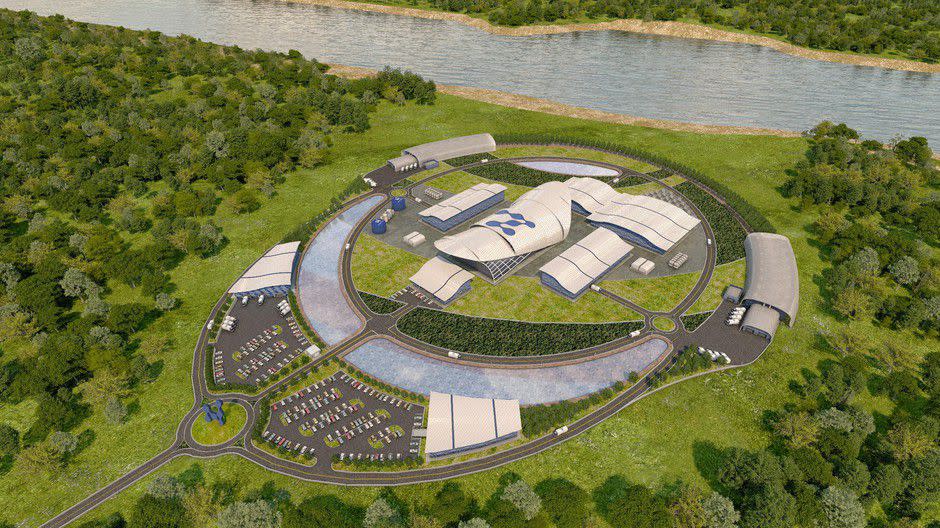Nuclear energy makes a huge showing at worldwide climate summit

The United States and 21 other countries have their eyes set on nuclear power generation, signing a pledge at a recent global climate conference to triple capacity by 2050.
U.S. presidential administrations that include Barack Obama, Donald Trump and Joe Biden have all demonstrated commitment to the development of advanced nuclear reactors, with the U.S. Department of Energy pouring billions into their development.
The declaration was made at the COP28 conference held in Dubai, recognizing that nuclear energy is already the second largest source of clean, dispatchable, baseload power, with benefits for energy security. It also states that a key appeal of nuclear energy is that nuclear technologies would occupy a small land footprint and can be sited where needed, partner well with renewable energy sources, and have additional flexibilities that support decarbonization beyond the power sector.
In the United States, nuclear power represents 18% of the country’s energy portfolio. Fossil fuels, which include natural gas, coal, petroleum and other gasses, accounts for about 60% and renewables such as solar, wind and hydropower are at 21%, according to the U.S. Energy Information Administration.
Signatories to the pledge at COP28 beyond the U.S. include France, the United Kingdom, the Republic of Korea, Finland, Japan, Hungary and Ukraine.
The daunting cost challenge
The planned NuScale small modular reactor plant at Idaho National Laboratory, which would have served some Utah customers, was recently scrapped due to costs. Potential subscribers mutually agreed that it had just become too untenable due to the price of energy that would have been delivered.
The Utah Associated Municipal Power Systems had put money in the effort to develop what was deemed the Carbon Free Power Project. It was years in the making and to NuScale’s credit, it was the first of its kind to receive design certification from the U.S. Nuclear Regulatory Commission.
But it was a rigorous, arduous and lengthy process that ultimately ended up with the cancellation of the project located just a few hours north of Salt Lake City. One of the biggest hurdles to licensing “small” nuclear is that this is new technology for which the NRC does not have a regulatory blueprint designed for this next-generation technology — and there are myriad of designs they have to grapple with.
UAMPS pursued nuclear to secure a strong portfolio of energy sources. It already has investments in wind and solar, and with the pressure to accelerate the retirement of coal-fired power plants, it wanted to solidify its energy future.

But being first is not necessarily being the most viable because NuScale shouldered the burden of proving to the world it could come up with a financially scaleable and appealing power source with technology that critics still question.
While a blow the U.S., NuScale has not abandoned its plans to pursue the adoption of its small modular reactor technology elsewhere.
Even though the Carbon Free Power Project is on hold, as UAMPS likes to emphasize, NuScale Power has signed 19 active domestic and international agreements to deploy SMR plants in 12 different countries, including Poland, Romania, the Czech Republic, and Jordan.
The Carbon Free Power Project envisioned six modulars cooled by a pressurized loop of water to deliver 77 megawatts each to produce a combined 462 megawatt hours of electricity per year.
While it may be shelved, UAMPS chief executive officer and general manager Mason Baker told the Deseret News recently that the Carbon Free Power Project will not be permanently discarded to a back room to gather dust. It just needs time to become fiscally feasible.
Related
Utah just lost an important future energy source. Here’s why
Why it takes so long to get advanced nuclear reactors up and running
Nuclear power is not a whim for Utah and is something that PacifiCorp, too, is pursuing for when its pair of coal-fired power plants retire in Emery County.
In this case, the utility is looking to use Bill Gates’ TerraPower Natrium’s reactors to replace those plants, set to retire in 2032. PacifiCorp signed a memorandum of understanding with TerraPower for adding up to five fast sodium nuclear reactors featuring molten salt storage. TerraPower and GE-Hitachi are the companies behind a western Wyoming plant at Kemmerer, where there is slated to be a demonstration project.
The coal to nuclear transition is an area of emphasis for both the federal government and states as coal is phased out as an energy resource amid increasing regulations, climate change and political pressure.
Related
Should there be a nuclear power plant in Utah? Most residents say yes
Retiring coal-fired power plants need a replacement. These Western states may have the answer
The promise of small nuclear
The global race is on to deploy small nuclear reactor technology and China managed to come in first.
It announced this month it began commercial operations of a fourth-generation nuclear reactor plant, according to the media outlet Reuters.
The 200-megawatt high temperature, gas-cooled reactor plant developed jointly by state-run utility Huaneng, Tsinghua University and China National Nuclear Corporation uses a modular design.
James Walker, head of nuclear development for NANO Nuclear Energy said the world is coming to a new reckoning as far as nuclear energy goes.
He pointed to Germany, which shuttered a trio of nuclear power plants in favor of wind and solar but ended up in such a power deficit the country was forced to buy fossil fuels from Poland and elsewhere, resulting in an overall increase in carbon emissions.
Walker said the move toward nuclear is inevitable.
“There’s obviously been a very big global push towards zero carbon emissions. There have been attempts in the past to move towards renewables such as wind and solar, but they haven’t been as successful as people wanted.”
The problem, he said, is that to scale a solar plant for battery storage so it is a constant source of energy requires more than two times the energy capacity that is needed. Companies have gone into the red. Aside from that, there is the massive footprint both wind and solar require from the land and its conflicts with endangered species, such as eagles.
Why NANO may hold a key to the future of nuclear energy
“Because nuclear is a form of consistent energy, with zero carbon emitting, it can be put anywhere in the world,” Walker said, boosting a country’s energy “sovereignty.”
Its land requirements, as mentioned, are small and countries are awakening to that realization, he added.
“That’s pretty much why they’re going in this direction. And nuclear is basically the only thing they’ve realized that can get them towards this zero carbon emissions goal.”
Walker said NANO has directed a bulk of its attention to the development of microreactors — smaller than the small modular reactors — and easily transportable via truck and set up in a variety of situations such as to backstop power for a hospital in emergency situations, dispatch centers, the military and more.
The company has been working with the Idaho National Laboratory to develop a demonstration project near the sprawling complex, which has its own experience in the development of microreactors, such as MARVEL, a fast-tracked project engineered by their nuclear science team.
Related
A sedan-sized microreactor could change billions of lives on Earth
A solution to Utah’s air quality problem? Heavy industrial plants
The company uses passive cooling reactors dubbed Zeus and Odin.
The products are in technical development. Zeus is a solid core battery reactor, and Odin is a low-pressure coolant reactor, each representing advanced developments in portable, on-demand capable, advanced nuclear microreactors, according to the company.
Walker said the beauty of Zeus is its simplicity.
“It‘s pretty much the most basic type of reactor you could possibly make. Again, if everything was to break simultaneously in this reactor, it would passively cool. It is very, very safe and gives you 15 years of power and then you just put it down. As soon as it was exhausted, you’d come in, remove the fuel from the reactor and the liability to the site would be completely gone.”
Walker says he expects there to be a two-year demonstration phase, followed by a little more than three years toward licensing.
“We’ll have a prototype reactor that’s ready for licensing,” he said “We’ll have a product that’s ready to deploy anywhere in the world.”
He added that a big problem the United States is reckoning with is the lack of having the necessary pathways to bring advanced nuclear technology a reality.
“The problem at the moment in the states is that a lot of the national infrastructure has atrophied. So, they they need to build back things like deconversion facilities, fuel fabrication, enrichment and transportation costs for moving highly enriched uranium around at the moment,” he said. “All of these things can be done one off at a great, great expense, but the once that infrastructure is built back up, the cost of fuel will come down dramatically and that’s usually the highest cost component within a reactor.”
The halo of HALEU
NANO is also pursuing the most important component of making nuclear energy viable for countries — HALEU.
High assay low-enriched uranium is the panacea for the operation of advanced nuclear reactor technology to be successful.
The U.S. Department of Energy projects that more than 40 metric tons of HALEU will be needed before the end of the decade, with additional amounts required each year to deploy a new fleet of advanced reactors.
Walker said historically, the U.S. has imported weapons grade uranium from Russia, but with that relationship on the skids — it is having to look elsewhere for the fuel, which has to be down-blended to reach a desired threshold for advanced reactors.
The U.S., he added, is looking to get that source of fuel from other countries and has also sent out a series of request for proposals to build up the necessary infrastructure in the United States.
Walker’s company wants to develop a pipeline for that fuel for all in this advanced nuclear arena to succeed.
The company’s website points out this: “More than 20 U.S. companies are developing advanced reactors that will change the way we think about the nuclear industry. The majority of these designs will require a fuel that isn’t yet available at a commercial scale. These companies can’t bring their reactors to life without HALEU.”
That is the next big step the company is pursuing.
“Once the infrastructure is built back and these things are being produced at quite a large scale, then you’ll end up at a point where nuclear will beat out gas or coal or wind or anything like that in terms of cost.”

